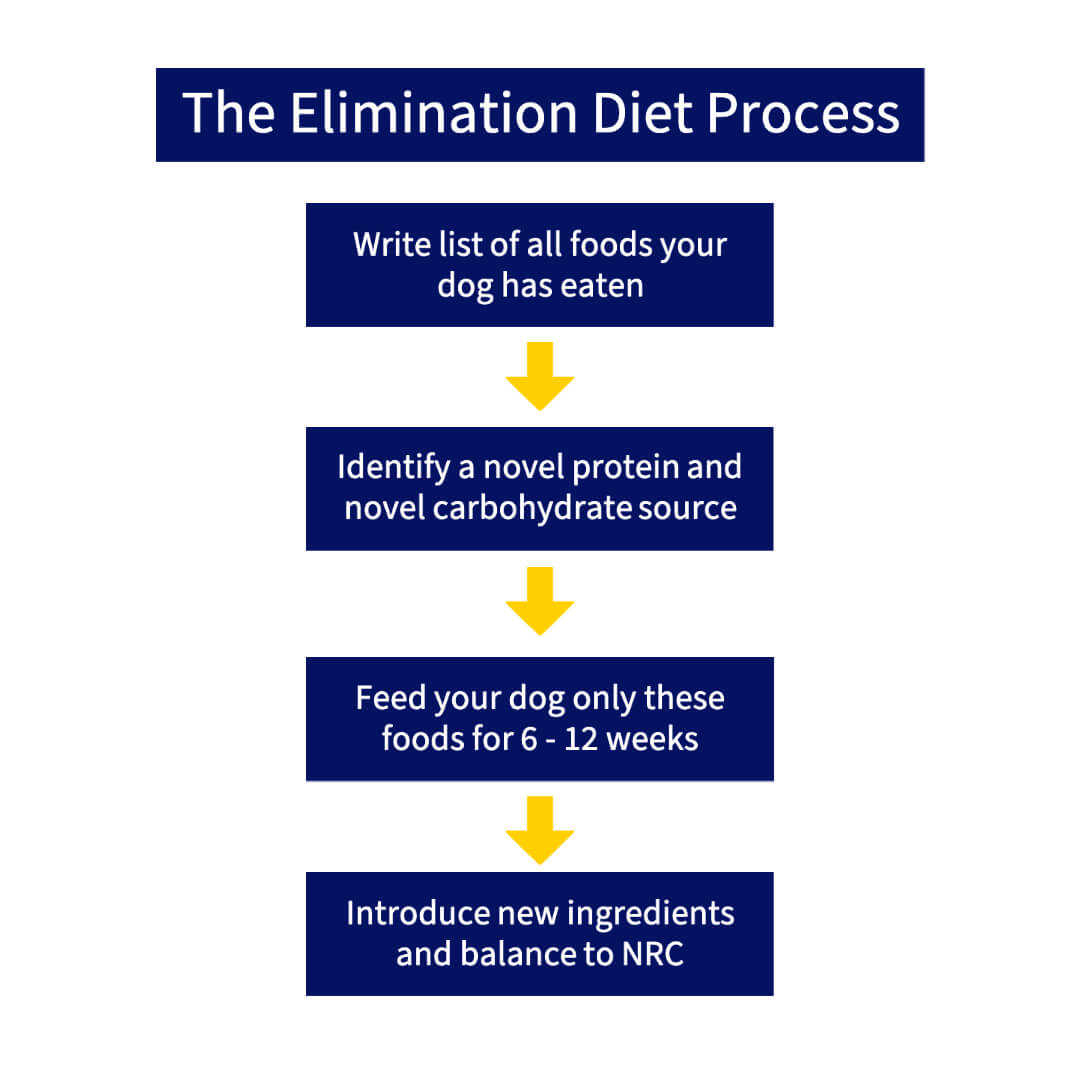Updated August 2023 by Kristina Johansen
If you’re concerned that your dog has a food intolerance or a food allergy, there is a process you can follow to help your dog, and significantly improve symptoms.
This process is called an ‘elimination diet,’ and it’s exactly what it sounds like – a procedure that aims to identify and limit specific foods that may trigger your dog’s allergy symptoms.
An elimination diet isn’t a complex thing but it’s a slow process and takes dedication and total control of your dog’s environment.
Before we dive into the elimination diet process, let’s just take a moment to understand the difference between an allergy and a food intolerance. People often use these terms interchangeably to describe any adverse food reactions in dogs, but there is a significant difference between the two.
Allergy vs intolerance
A food allergy causes your dog to mount an immune response to an ingredient found in food (usually a protein). Even a tiny amount may trigger an allergic reaction, and it can be severe and even life-threatening. These reactions can occur within minutes to hours of ingesting of a food that the body has declared harmful. Imagine a peanut allergy in humans, and you’ll know exactly what I’m referring to.
In contrast, a food intolerance is a physiological response to a food that does not affect the immune system, and it’s never life-threatening. Symptoms of food intolerance generally take longer to appear than symptoms of allergies. Depending on the type of food intolerance your dog has, he may be able to eat small amounts of a problem food without a reaction.
Any type of ingredient can cause both a food intolerance and allergy, with dairy, chicken, egg, and beef being some of the more common culprits. Additionally, too much fat, too much or too little fibre, or a diet with other properties that don’t agree with your dog can also cause a food intolerance.
So, how can you identify and eliminate these foods and ultimately improve your dog’s health?
Step one: eliminate and identify
The first step in an elimination diet is to make a list of all the foods you have previously given your dog. It might be challenging to remember all of them, but do your best and write them down.
Once you’ve got your list, it’s essential you choose a protein and a carbohydrate that your dog has not eaten before. This approach reduces the risk of pre-existing sensitivities interfering with the elimination diet process.
Examples of novel proteins, which most dogs haven’t consumed before, include venison, duck, mackerel, rabbit, kangaroo, and pheasant
Opt for a gluten free carbohydrate. Gluten is a type of protein found in certain grains such as wheat, bulgur, and rye. Examples of gluten-free carbohydrate include potatoes, sweet potatoes, rice, quinoa, or buckwheat.
Step two: 6 – 12 weeks trial
It’s good to keep in mind that there’s an element of trial and error with identifying a protein and carbohydrate that your dog will do well on. That is, you may have chosen a protein and carbohydrate that your dog hasn’t had before, but it may still cause problems.
If your dog develops new symptoms or their symptoms worsen while consuming the novel protein and carbohydrate you first choose, change them out one at a time. For example, first swap the novel protein source for another, then if the symptoms continue, replace the carbohydrate source with another, and so on.
Repeat this process as necessary until you find a protein and carbohydrate source that your dog can tolerate. Once you have done this, the next step is to feed your dog only these foods for a minimum of 6 weeks, but preferably 8-12 weeks. During this period, do not give your dog any treats, chews, other food, or supplements.
Step three: Introducing new ingredients
The elimination diet is not a balanced diet, and by now, you have had your dog on a very restricted diet for maybe a few months. This doesn’t present an immediate problem for an adult dog. Your dog’s body has a storage of nutrients it can draw on if a nutrient is lacking. However, it’s time to restore those reserves.
Going forward, you should now balance the diet according to the NRC guidelines
Calcium plays a vital role in your dog’s health so you should make it your first addition. Add it to your dogs food for a minimum of 4 weeks to note any reactions. Assuming your dog does well, you can move on and add a new ingredient to provide missing nutrients.
If you are unsure how to balance your dog’s diet to meet the NRC nutrient requirements, it’s vital to consult with a nutritional specialist. Together, you can ensure your dog gets all the essential nutrients needed to stay healthy.

It’s a slow process, but don’t quit
Elimination diets are time consuming, can last for up to 6 months and you may not see results right away. You may get frustrated at a perceived lack of progress half-way through and want to give up. Don’t! Stick to the plan.
You won’t see a massive change or a big breakthrough overnight. However, the long-term benefits to your dog, once the offending food type has been identified and they no longer have allergy or intolerance symptoms, will be worth it.
On top of this, it should be remembered that a blood, saliva or fur test isn’t accurate enough to diagnose a food allergy or intolerance. So, as challenging as they may be, an elimination diet is the only truly effective way to identify the food type that is causing your dog discomfort.
So, some top tips for an elimination diet are: Be patient, stick with it and remain positive.
Meet Patchi
Her owner contacted me when Patchi was suffering from food allergies, causing her to lose fur around her neck and other parts of her body. Patchi was put through a food elimination diet. Three months later, she’s no longer scratching and her gorgeous fur has grown back. I’m so pleased to have been able to help Patchi and to have been a part of this incredible transformation.

I hope the information in this blog has been helpful. If you have any questions or suggestions on how I can improve the blog, please email me at kristina@elmoskitchen.com
Additional reading:

